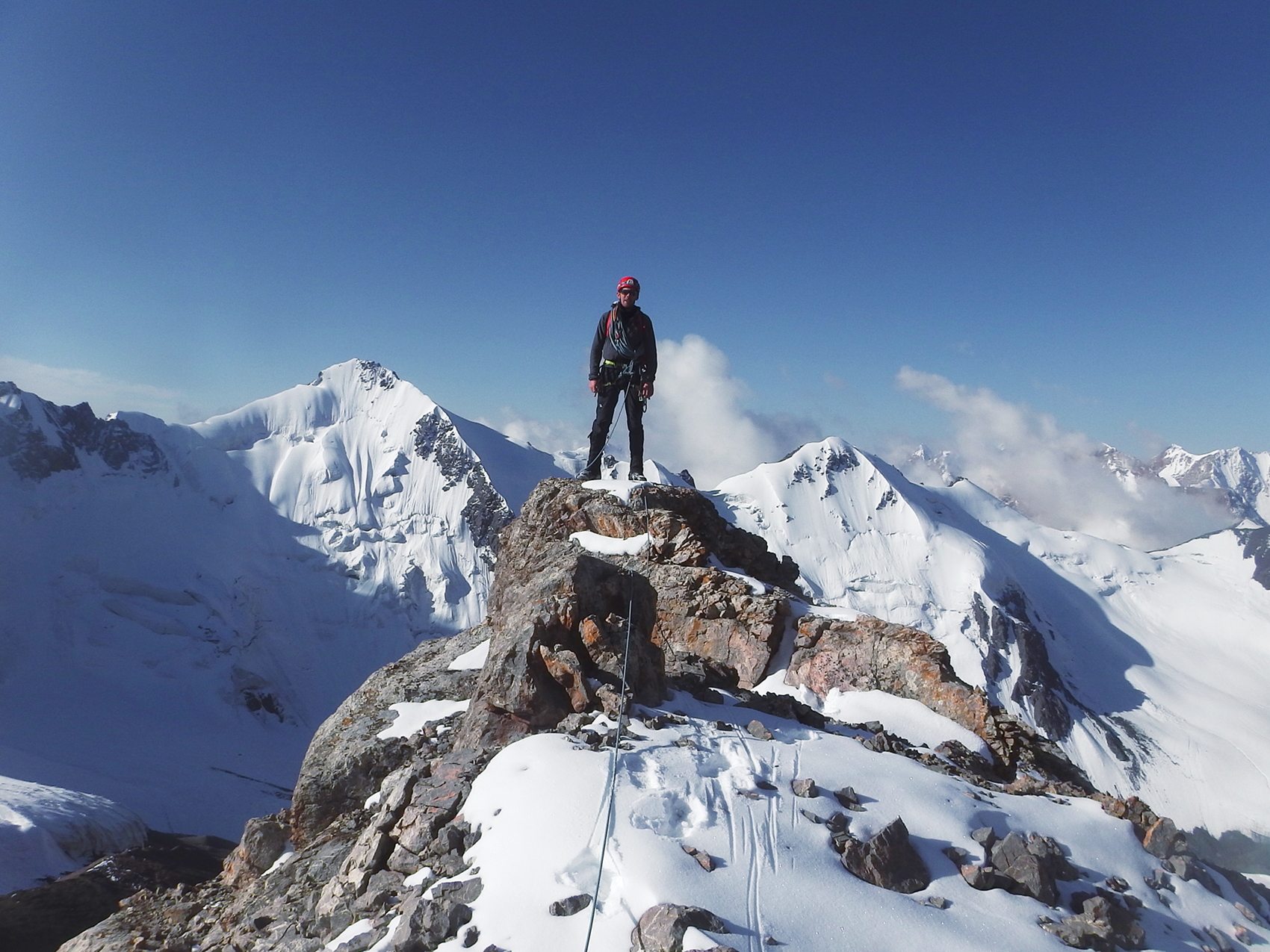
We’ve been climbing for several hours through knee deep, energy sapping snow. The only exception to this was getting to the other side of a crevasse that would comfortably swallow my small car, along with the house it’s currently parked outside four and a half thousand miles away, and still have plenty of space for the diminutive mountaineers daring to cross. Warily making our way across a snow bridge which offered the only obvious route, I’m acutely aware of the risks. We all are. Crevasses kill dozens in the mountains every year, and none of us want a Joe Simpson’s eye view of the inside of a glacier. Yet, there is nowhere else any of us would rather be. Incredible peaks are all around us, all covered in rock, snow and opportunity. We’re at 4800m, heading to the summit of an unclimbed mountain that’s pinnacle is around 5040m. But this isn’t the only objective of our expedition. As a group we’ve already recorded first ascents on eleven incredible mountains before this one. But none above 5000m. Yet. So we take deep breaths of the thinning air and gaze up the summit ridge. It’s only a couple hundred metres of ice and rock, bordered on the right by cornice and nothingness. Tom leads the way, hoarding the ice screws and finding his way upwards, with the rope partners below increasingly grateful for any steps cut into the slope, steps which are getting thinner and thinner as the ice hardens…
Seven made up the expedition flying out from Heathrow, drawn from all over the UK but all heading for Kyrgyzstan. Neil Cox, the Exped leader and itinerant actuary; Matt Lewis, the token Peak District grit addict; Stuart Gillan, our mountain rescue (and peanut butter) guru; Tom Harding, resident cartographer; Hannah Meinertzhagen, the Exped scientist and nature buff; David Ewing, our doctor, lifeline and drug dealer; and, finally, me, the token Scott Martin (except I wasn’t, as so was Stuart) and head chef. Our target; the Borkoldoy Range in the Tien-Shan, where we had identified an area with numerous unclimbed mountains up to and above 5000m. There had been previous expeditions into the region which had enjoyed varied degrees of success (and in the case of one expedition, success had resulted in some rather dubious mountain naming, but to the victor the spoils). Tom, our cartographer, concluded after painstaking research that the mountains surrounding our base camp looked big, accessible and, most vitally, unclimbed. So, with heavy kit bags and an almost unhealthy level of enthusiasm we set out from the capital, Bishkek. Half a tonne of personal kit, technical group kit, food, supplies and tents were loaded into our vehicles, initially a simple van but latterly a 10-tonne behemoth of Russian construction, all re-enforced steel suspension and ridiculously thick rubber tyres, that would drive on happily hours after leaving the roads far behind. All this, along with some packhorse manoeuvres in the dark, found us at the site for our base camp, and oh what a sight it was. A long glacial ribbon lake, powder blue and constantly fed by meltwater, bordered by sudden and boulder-strewn slopes that arched ever more steeply upward to castles of rock and ice. Valleys, unexplored and largely un-gazed upon by human eye, branched off on either side of the main gorge, climbing into high and hidden recesses that we would spend the next three weeks uncovering. None of us could wait.
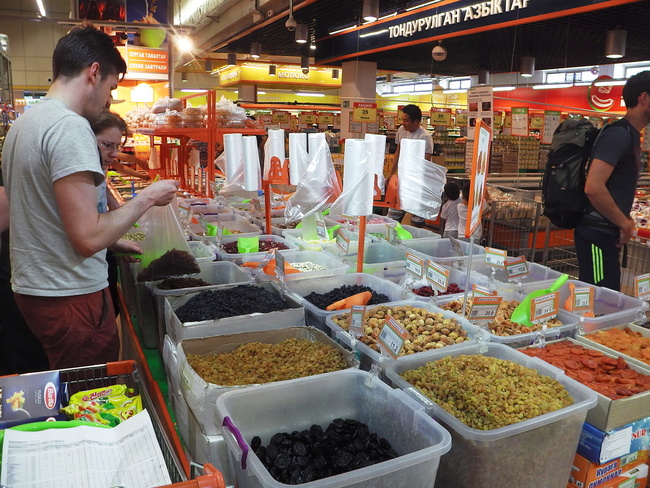
Buying food for the 3 weeks
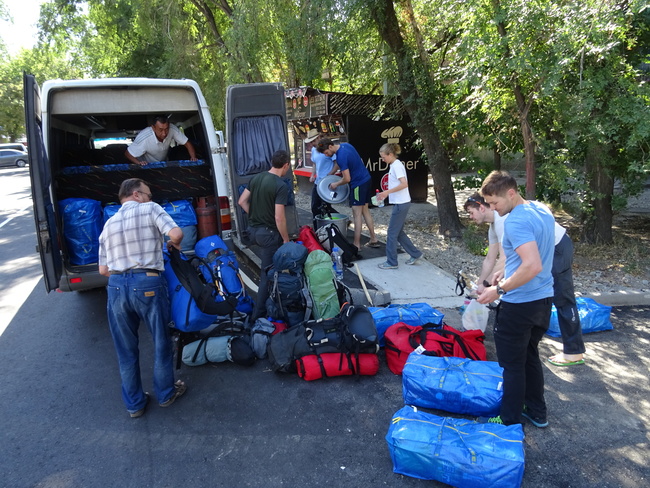
Hundreds of kilgrams of kit being loaded
With seven in the expedition, climbing parties were largely split into twos and threes. The first climbing day saw two groups of two head off to the “Kyrg Wall Slabs”, enormous 400m tall sheets of rock that made their Idwal counterparts somewhat insignificant by recollective comparison. Conquering these led to a large bowl filled with a wonderful terrain that we would all come to know like the alcoholic knows the morning after; scree. The frost shattered nature of the limestone meant that, whilst very grippy where it was solid, large amounts of it had peeled off over thousands of years of battering by the elements. Progress up the bowls and gullies could feel like climbing up marbles at times, but these trials were put far into the back of the minds of the climbers when the summits were reached. The first summit of the expedition, overlooking or base camp valley and with incredible panoramic views over the range to our south, was GPS fixed at 4576m. Back home, light aircraft aren’t allowed to fly above 3000m as the lack of oxygen can result in the pilot losing consciousness. Needless to say, finding yourself a mile higher up than that can leave one a little short of breath!
A second summit was conquered the very next day, with the three base camp convicts from the previous day wasting no time to taste the rarefied atmosphere of a first ascent. The long approach up a glacier ended in a spectacular ridgeline summit at 4418m, one side bordered not by a cliff but a clear overhang; not a place to hang around! This route also brought us the first tick on one of our scientific objectives for the expedition. A charity named Project Pressure work to document the world’s sadly vanishing glaciers, collaborating to inspire action on this global issue. As we would be venturing near glaciers that had rarely, if ever, been documented then we could add to their invaluable wealth of knowledge with geotagged photographs. This we did at several locations where we were climbing along with a couple of spots on our route out of the expedition.
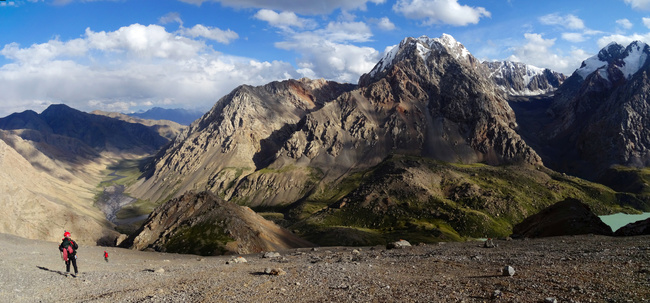
Basecamp was by the lake on the right
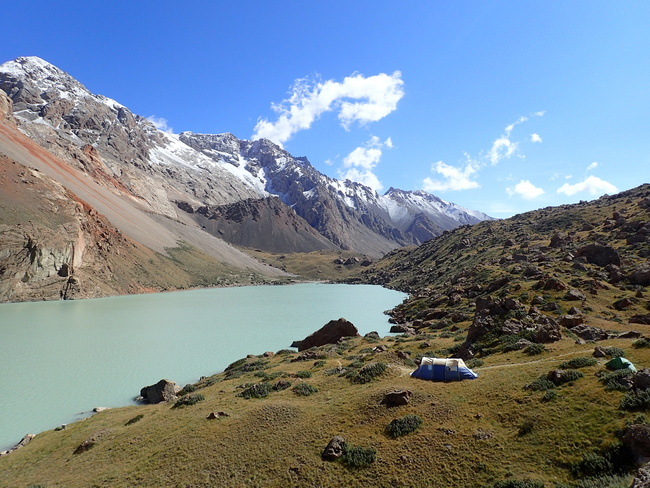
Beautiful Basecamp
Several more climbs were attempted over the rest of the first week, most of them successful. There was an attempt on one of our primary objectives by Neil and David, aiming at the unclimbed peak the map claimed as around 5020m. They made a bold dawn ascent of an ice wall at the back of what was christened “Scree Valley” (guess what that approach was like) to reach a first ascent summit of 4701m. However, the route to the higher top was over a ridgeline that could give the boldest mountaineer the heebie-jeebies, all loose rock and broken ice with lots of air beneath your feet. Hoping to find a better approach further round the mountain, the two of them circumnavigated round, sadly returning with the conclusion that this was one mountain too far. We would have to find our 5000er elsewhere.
Matt and I at this point went on a trip up the main valley of Kainar Gorge, looking to scout a valley much further up that the map hinted could contain some terribly tempting targets, and a possible site for an advanced base camp. This walk in itself wouldn’t be anywhere near as arduous, but it was anything but Plain Jane boring. Reaching the end of our glacial lake led to an alluvial outwash plain, flanked by an enormous waterfall on its north side. Further up, this led to a spectacular Alpine meadow and the first sighting of Ibex. A herd of 50 or so of the magnificent creatures were grazing on the lower flanks of the mountains, with several young seen playing ahead. Either through sight, sound or smell they detected us from 200m away and were off, bolting up to the rocky slopes and climbing with the sure-footedness found in so few other animals that put our efforts very much to shame. It was a magical moment amongst many with the local wildlife; from Lammergeiers circling our heads in inhospitable valleys to Barbary Falcons flanking the bus. From marmots struggling to run like they’ve massively overeaten through to the Weasel who flitted around with a keen curiosity at base camp on our last lazy afternoon. Our resident Pika at the advanced base camp was an elusive but often present companion, and the Hawk Moths who would buzz someone’s ear when reading, making them think a zeppelin had just passed close by, were a never-ending source of amusement to the onlooker. All of these moments were a reminder to us of how wild and special a place this was.
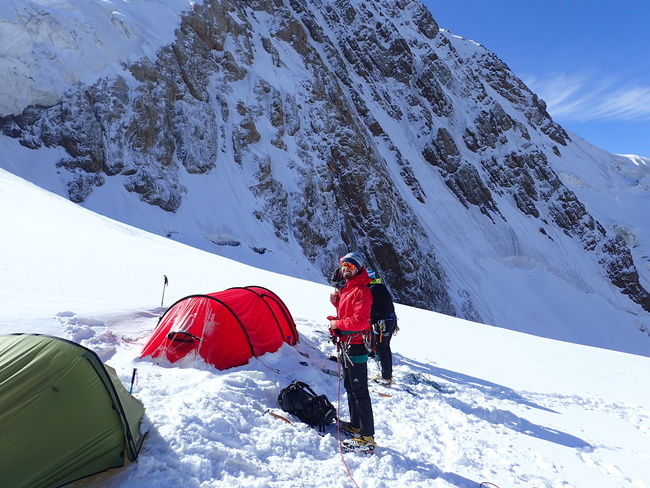
It would be another week before the final attempt for her summit. Hannah, Neil and Tom trail-blazed to find the route, setting the high camp on the glacier on the approaches at 4660m. Overnighting here they attempted and Alpine start to summit in the morning. However, cumulative fatigue and insufficient calories exacerbated the altitude sickness of two of the party meaning a retreat was necessary. Brief respite at the high camp allowed for sufficient recovery to allow the three of them to reach base camp proper for several days of rest and just as importantly, food. It’s a minor miracle how much a simple but freshly cooked and warm meal can lift the spirits when you’re all but broken. Some camp cooked flat breads (which became a firm favourite) and weight off the feet allowed the three to make another attempt. They were joined by David and I, tagging along as a separate rope group to attempt the summit. We ascended to the high camp that still bore the evidence of the trio’s previous trip; the ledge dug out of the snow to accommodate the tent. Sadly, the ledge wasn’t big enough for the two tents (the lazy sods had only dug space for one on their previous trip, so inconsiderate) so some high-altitude digging was needed. The only tools for the job were ice axe adzes, making for a tiring dig at the end of a draining climb. Quick work was absolutely necessary though, as the afternoon blizzard soon hit, confining the parties to their tents.
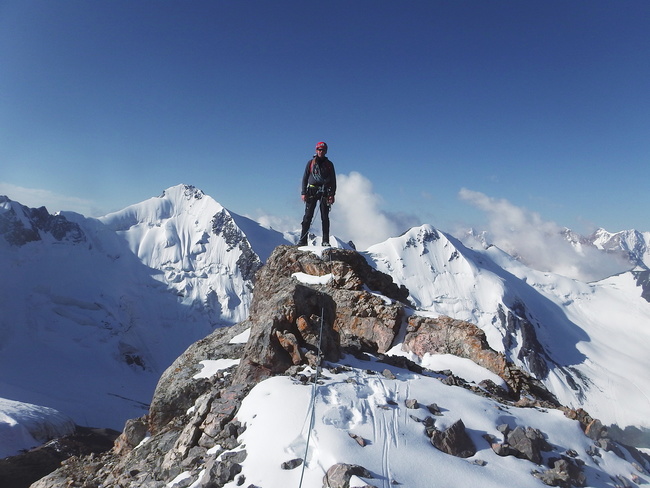
Neil on the summit of one of the peaks
There is one trial that every mountaineer must pass when camping high. A tedious task that is absolutely necessary; melting ice and snow for drinking water. Not only does it take ages (needing to melt roughly 10 times as much snow for a given amount of water) but the end result is hardly aqua vitae. Still, needs must, especially when there’s tea to be brewed. With night quickly settling in and the temperature falling fast, there was little else to do but to nestle into our sleeping bags. The one issue was the thickly falling snow piling up our tent, threatening to collapse it. There was little option but to regularly shake the tent from the inside, hoping to dislodge the build-up of snow without causing the tent to fall in around us! I can’t pretend that it was the comfiest night’s sleep I’ve ever had. Two guys in a small tent in the cold results in a fair amount of condensation, which unfortunately results in a thick layer of hoar frost on the inside. The slightest of movements resulted in indoor snow showers, the perfect wake up call for a summit day. But what a day. And what a morning. Brilliant sunshine poured over us from the moment the sun peeked over the horizon, warming our chilled bodies and energising us for the day.
There is some difficult and dangerous terrain ahead, with crevasses and bergschrund to safely cross. We prepare our gear, roping up in two teams and head up the glacier, aiming for the summit ridge. Tom was ploughing through knee deep snow like a machine, making light work of what was clearly tough trail breaking. He soon reached the first major obstacle, a substantial bergschrund with only one route across; a thin snow bridge followed by a traverse over steep ground running out into a crevasse. Don’t look down! Thankfully the thick snow allowed for reassuring steps to be kicked into the slope over the steepest sections, with belays providing the reassurance when needed. Immediately we found ourselves at the most incredible saddle between two 5000m peaks. Incredible ridgelines added to the breath-taking vista, but we had little time to stand and stare. The summit ridge was ahead, taking us back to earlier. What had previously been thick snow became nothing but ice, with winds stripping away any powder lying on the ground. A few traverses required ice screw protection, but without too many incidents we suddenly found ourselves at a heavily corniced point where ground fell all around. The all-important GPS measurement was needed before we could be sure of our height. 5042m. The weather had held off and we were rewarded with views over miles and miles of pristine wilderness. We all sat on the summit and drank it in, recovering from our efforts and relishing the sheer joy of existing in such a fine place. The summit is not the reason that we mountaineer, it is never the sole aim and the imperative to put the human body into such places is not driven purely by a desire to stand on the top. However, there is no denying that such a moment can crystallise the payback for months of planning, effort and sacrifices. That moment we shared on the summit gave back in spades.
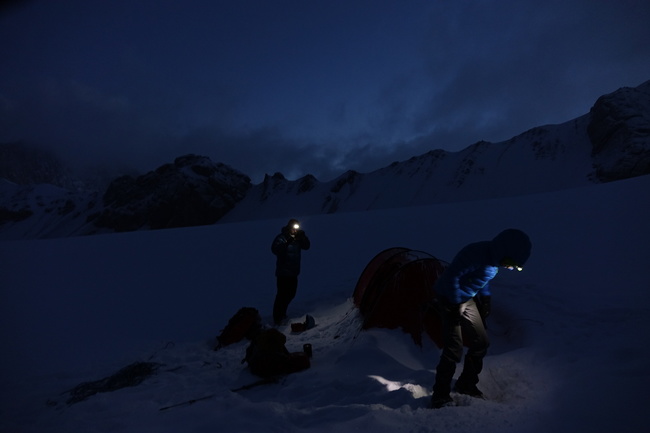
Setting off from high camp – Attempt 1 of the the 5000m peak (1)
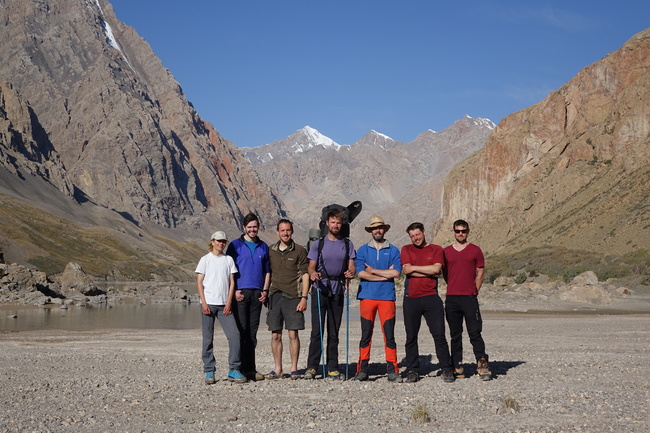
The team leaving on the last day
The remaining days in the mountains flew by. A few more summits were conquered before the end, taking our expedition total to fourteen recorded ascents. Hopefully they would prove to be most, if not all, first ascents. Confirmation of this would have to wait until the months after the expedition (as I write this we still await some degree of official confirmation) but that was not our concern in the last few days. These were spent finishing the last few routes on the camp climbing wall (6 new routes with a topo, Chossfax© Kyrgyzstan Edition to follow) and enjoying the last of our incredible camp. Before we knew it, we were packing the base camp and loading the pack horses to return to civilisation. The walk out of our gorge was bittersweet but the sun shone on our departure. We took one last group photo overlooking the lake and made our way out of the Borkoldoy and started for home.
It goes without saying that planning and executing such an expedition takes time, money and effort. Everyone involved most certainly gave all three, but some deserve thanks more than others. Our intrepid leader, Neil, carried out the vast majority of the logistical planning for this trip, all whilst spending many months journeying all over the world. His travels and travails are detailed at neilcoxmisadventures.com. Further to this, we were wonderfully supported by the British Mountaineering Council, the Mount Everest Foundation and Wilderness Lectures through their Wilderness Award, who most generously awarded us funding to support the expedition; our most heartfelt thanks to these organisations who give so much support to amateur mountaineers in all their imprudent adventures.
